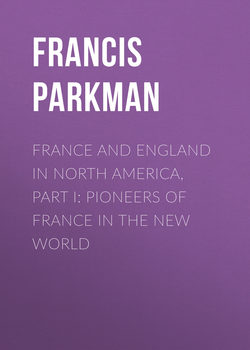France and England in North America, Part I: Pioneers of France in the New World

Реклама. ООО «ЛитРес», ИНН: 7719571260.
Оглавление
Francis Parkman. France and England in North America, Part I: Pioneers of France in the New World
INTRODUCTION
Part One. HUGOENOST IN FLORIDA
PREFATORY NOTE TO THE HUGUENOTS IN FLORIDA
CHAPTER I. 1512-1561
CHAPTER II. 1550-1558
CHAPTER III. 1562, 1563
CHAPTER IV. 1564
CHAPTER V. 1564, 1565
CHAPTER VI. 1564, 1565
CHAPTER VII. 1565
CHAPTER VIII. 1565
CHAPTER IX. 1565-1567
CHAPTER X. 1567-1583
Part 2. SAMUEL DE CHAMPLAIN AND HIS ASSOCIATES; WITH A VIEW OF EARLIER FRENCH ADVENTURE IN AMERICA, AND THE LEGENDS OF THE NORTHERN COASTS
CHAPTER I. 1488-1543
CHAPTER II. 1542-1604
CHAPTER III. 1604, 1605
CHAPTER IV. 1605-1607
CHAPTER V. 1610, 1611
CHAPTER VI. 1611, 1612
CHAPTER VII. 1613
CHAPTER VIII. 1613-1615
CHAPTER IX. 1608, 1609
CHAPTER X. 1609
CHAPTER XI. 1610-1612
CHAPTER XII. 1612, 1613
CHAPTER XIII. 1615
CHAPTER XIV. 1615, 1616
CHAPTER XV. 1616-1627
CHAPTER XVI. 1628, 1629
CHAPTER XVII. 1632-1635
Отрывок из книги
The story of New France opens with a tragedy. The political and religious enmities which were soon to bathe Europe in blood broke out with an intense and concentrated fury in the distant wilds of Florida. It was under equivocal auspices that Coligny and his partisans essayed to build up a Calvinist France in America, and the attempt was met by all the forces of national rivalry, personal interest, and religious hate.
This striking passage of our early history is remarkable for the fullness and precision of the authorities that illustrate it. The incidents of the Huguenot occupation of Florida are recorded by eight eye-witnesses. Their evidence is marked by an unusual accord in respect to essential facts, as well as by a minuteness of statement which vividly pictures the events described. The following are the principal authorities consulted for the main body of the narrative.
.....
Meanwhile Satouriona, "lord of all that country," as the narratives style him, was seized with misgivings on learning these proceedings. The work was scarcely begun, and all was din and confusion around the incipient fort, when the startled Frenchmen saw the neighboring height of St. John's swarming with naked warriors. Laudonniere set his men in array, and for a season, pick and spade were dropped for arquebuse and pike. The savage chief descended to the camp. The artist Le Moyne, who saw him, drew his likeness from memory, a tall, athletic figure, tattooed in token of his rank, plumed, bedecked with strings of beads, and girdled with tinkling pieces of metal which hung from the belt which formed his only garment. He came in regal state, a crowd of warriors around him, and, in advance, a troop of young Indians armed with spears. Twenty musicians followed, blowing hideous discord through pipes of reeds, while he seated himself on the ground "like a monkey," as Le Moyne has it in the grave Latin of his Brevis Narratio. A council followed, in which broken words were aided by signs and pantomime; and a treaty of alliance was made, Laudonniere renewing his rash promise to aid the chief against his enemies. Satouriona, well pleased, ordered his Indians to help the French in their work. They obeyed with alacrity, and in two days the buildings of the fort were all thatched, after the native fashion, with leaves of the palmetto.
These savages belonged to one of the confederacies into which the native tribes of Florida were divided, and with three of which the French came into contact. The first was that of Satouriona; and the second was that of the people called Thimagoas, who, under a chief named Outina, dwelt in forty villages high up the St. John's. The third was that of the chief, cacique, or paracoussy whom the French called King Potanou, and whose dominions lay among the pine barrens, cypress swamps, and fertile hummocks westward and northwestward of this remarkable river. These three confederacies hated each other, and were constantly at war. Their social state was more advanced than that of the wandering hunter tribes. They were an agricultural people, and around all their villages were fields of maize, beans, and pumpkins. The harvest was gathered into a public granary, and they lived on it during three fourths of the year, dispersing in winter to hunt among the forests.
.....